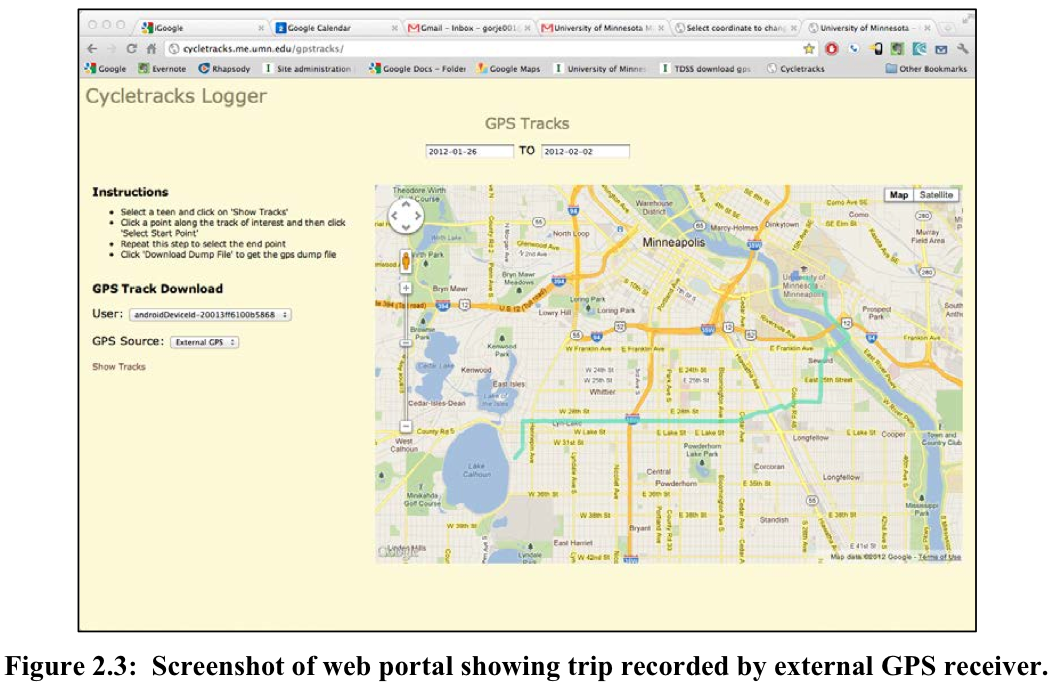INTELLIGENT TRANSPORTATION SYSTEMS INSTITUTE
Executive Summary
Researchers have shown that GPS units in smartphones can be used to identify routes taken by cyclists, including whether cyclists deviate from shortest paths to use bike lanes and other facilities. Researchers previously have not reported whether GPS tracking can be used to monitor whether and how bicyclists actually use lanes on streets, where these lanes have been provided, or other types of facilities. The objective of this research was to determine whether smartphone GPS units or enhanced GPS units could be used to track and map the location of cyclists on streets. The research included three tests:
- A comparison of the accuracy of the smartphone application GPS tracking system vs. a high-quality external GPS unit.
- A comparison of the accuracy of GPS measurements in various urban environments (e.g., urban canyons vs. bridges or other open streets).
- A comparison of smartphone performance among various manufacturers (e.g., LG vs. Motorola).
To complete these tests, the research team modified an open-source smartphone application (CycleTracks) to integrate with a higher-quality external GPS unit. Cyclists then mounted the smartphone with route-tracking applications to bicycles and repeatedly rode four different routes. The routes for the field tests were chosen because each included a striped lane for bicycle traffic and because the routes went through a variety of built urban environments, ranging from an open location on a bridge over the Mississippi River to a narrow urban street lined by tall, multi-story office buildings.
Statistical analyses of field tests demonstrated that:
- The GPS route traces provided by the external GPS units were significantly more accurate than the traces provided by the GPS units in the smartphones;
- The route traces provided by both the standard GPS and the external GPS were affected by the characteristics of the built environment along the route. The accuracy of the route traces in the “urban canyon” was significantly different (lower) than the accuracy along other routes. The accuracy of the traces over the bridge was highest.
- No significant differences in the accuracy of traces from different smartphones were observed.
The field tests also demonstrated that neither the smartphone GPS units nor the higher-quality external GPS receiver generate data accurate enough to monitor bicyclists’ use of bike lanes or other facilities. This lack of accuracy means that researchers interested in obtaining data about the propensity of cyclists to ride in lanes, when available, must rely on other technologies to obtain data for analyses. Because GPS data are sufficiently accurate to determine routes taken, researchers can infer decisions by cyclists to deviate from shortest-path routes to use bike facilities. Future improvements in GPS technology may facilitate the types of applications envisioned in this research.
Read full report (PDF) here: Feasibility of Using GPS to Track Bicycle Lane Positioning
About The Intelligent Transportation Systems (ITS) Institute
www.its.umn.edu
“The Intelligent Transportation Systems (ITS) Institute is a national University Transportation Center (UTC) funded through the Safe, Accountable, Flexible, Efficient Transportation Equity Act: A Legacy for Users (SAFETEA-LU) federal transportation bill, passed in 2005. This funding continues the Institute’s efforts initiated under the Intermodal Surface Transportation Efficiency Act of 1991 (ISTEA) and the Transportation Equity Act for the 21st Century (TEA-21) in 1998. “







 RSS Feed
RSS Feed